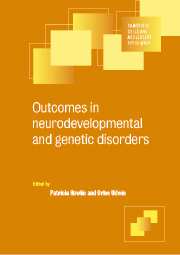Book contents
- Frontmatter
- Contents
- List of contributors
- Preface
- 1 Attention deficit hyperactivity disorder
- 2 Developmental language disorders
- 3 Reading and other specific learning difficulties
- 4 Metabolic disorders
- 5 Hemiplegic cerebral palsy
- 6 Autistic disorders
- 7 Down syndrome
- 8 Fragile X syndrome
- 9 Prader-Willi and Angelman syndromes: from childhood to adult life
- 10 Rett disorder
- 11 Tuberous sclerosis
- 12 Williams and Smith-Magenis syndromes
- Index
10 - Rett disorder
Published online by Cambridge University Press: 13 August 2009
- Frontmatter
- Contents
- List of contributors
- Preface
- 1 Attention deficit hyperactivity disorder
- 2 Developmental language disorders
- 3 Reading and other specific learning difficulties
- 4 Metabolic disorders
- 5 Hemiplegic cerebral palsy
- 6 Autistic disorders
- 7 Down syndrome
- 8 Fragile X syndrome
- 9 Prader-Willi and Angelman syndromes: from childhood to adult life
- 10 Rett disorder
- 11 Tuberous sclerosis
- 12 Williams and Smith-Magenis syndromes
- Index
Summary
Introduction
Since it was described in 1966 by the Viennese neurologist Andreas Rett, the Rett syndrome has become familiar as a striking and consistent phenotype, affecting girls who look remarkably normal but display unusual behaviours associated with disturbed cognition, movement and autonomic control. In the final months of 1999 the underlying genetic problem was identified at Xq28, in the gene MECP2 (Amir et al., 1999; Wan et al., 1999; Cheadle, Gill & Fleming, 2000) and a simple and reliable genetic test for the disorder will now certainly be developed. However clinical recognition must come before such a test can be correctly applied or interpreted and this recognition will depend on awareness by health professionals of the picture they should expect to meet in clinical practice. Over 950 families have contributed health information about their affected daughters to the British Isles Rett Survey (see Kerr, 1992a). Of these, 472 are aged over 18 years, the two eldest being 66 years. I have drawn extensively on my experience with all these people in writing this chapter.
The task has now begun of matching the longitudinal health information from this and other clinical studies with the known anatomical and biochemical abnormalities in the brain and relating these to the MECP2 defects. Although parents are usually the first to identify problems, the early symptoms may not be recognized by clinicians.
- Type
- Chapter
- Information
- Outcomes in Neurodevelopmental and Genetic Disorders , pp. 241 - 271Publisher: Cambridge University PressPrint publication year: 2002
- 3
- Cited by

